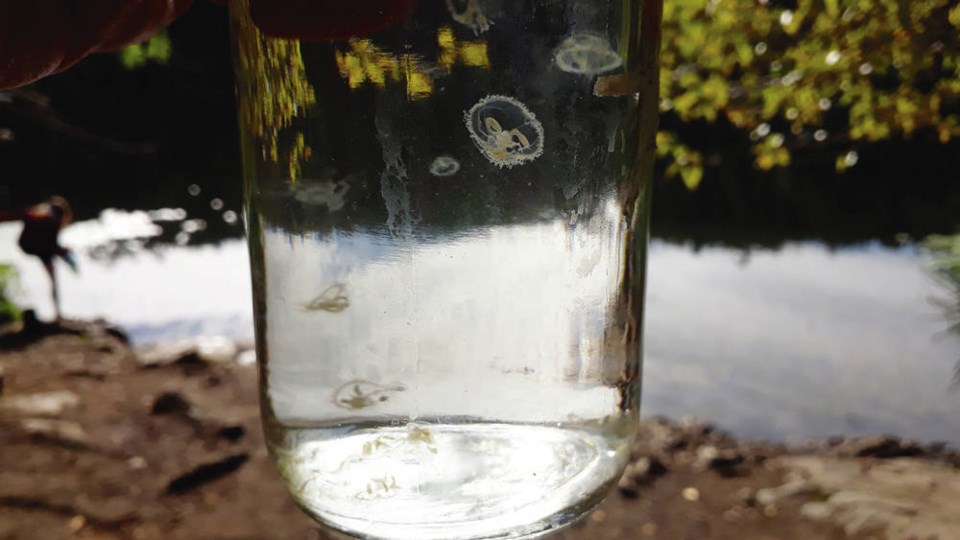The tiny freshwater jelly fish invading Killarney Lake in Saanich have also been reported in nearby Maltby Lake and at least two other lakes near Campbell River and Port Hardy, says a UBC marine biologist studying the outbreak.
Florian Luskow said reports of craspedacusta sowerbyi blooms began pouring in after the Times Colonist reported on his collection efforts at Killarney Lake last weekend.
He said warm weather and the pandemic have brought thousands of people out to different lakes and they are noticing the thumbnail-sized jellies.
The invasive species is not harmful to humans. Although similar to their ocean cousins in that they can sting prey, these jellies are so small that they are unable to pierce human skin.
The effect on lake ecosystems, however, isn’t clear.
The first documented outbreak of craspedacusta in B.C. was in 1990 at Durrance Lake in Saanich, northwest of Killarney Lake. The Royal B.C. Museum has wet samples of that outbreak in its collection, as well as others from a 2002 outbreak in Maltby Lake and a 2009 case in Langford’s Florence Lake.
But there have been several other reported outbreaks, including a 2013 bloom on the east side of Shawnigan Lake near Old Mill Park.
Dave Hutchinson, who wrote an extensive story about the outbreak in the Shawnigan Focus, a community publication, said Friday he hasn’t heard of the jellyfish returning since then.
But he says his mother and other residents have said the jellyfish were in Shawnigan Lake as early as the 1940s and 50s.
“It makes you wonder what determines their cycle, even as the decades go by,” said Hutchinson.
The freshwater jellyfish originated in the Yangtze River in China, but has proliferated in fresh water around the globe as an invasive species. One of the theories is that it was brought here in the late 19th century attached to the roots of water lilies.
The provincial government, which has authority over public waterways, has listed the freshwater jellyfish as invasive, but ranked it at a low level of action. It is described as under management, where the species is widespread, “but may be of concern in specific situations with certain high values (conservation lands, specific agriculture crops). Management objective is to reduce the invasive species’ impacts locally or regionally, where resources are available,” says the Environment Ministry.
Luskow said the jellyfish can move from lake to lake via plant materials, birds, paddleboards or ballast water from boats.
He suggests people thoroughly clean their equipment after using lakes.
Saanich resident Ali Rivers agrees. “Now that it is [in Killarney Lake], it’s much more likely to be able to travel between other waters on personal equipment. In fact, this is why many lakes have signs reminding people to clean and dry such equipment.”
Lüskow said little is known about the jellyfish’s effects in lakes. He said fish are not consuming them, but they might compete for food resources.
Lüskow said for most of the year, jellyfish populations only exist in the form of polyps attached to submerged rocks and tree trunks.
When lakes are cooling in the fall, the jellyfish disappear, leaving planktonic larvae that settle and become polyps. When the water warms up, polyps asexually reproduce many medusae, which are the sexually reproducing life stage.
Lüskow said his pilot study is to understand the distribution and impacts of the jellyfish on lake ecosystems in B.C.
He said Friday new outbreaks have been reported to him in Echo Lake at Campbell River and Joes Lake in Port Hardy.
“The frequency of reports has increased exponentially since the 1990s and we received more than 35 reports between 2011 and 2020. For comparison, in the decade before (2001 to 2010), we only received 11 reports.”
Luskow said that might be related to increasingly favourable conditions for the jellyfish to thrive with global warming, or to increased observational efforts.



